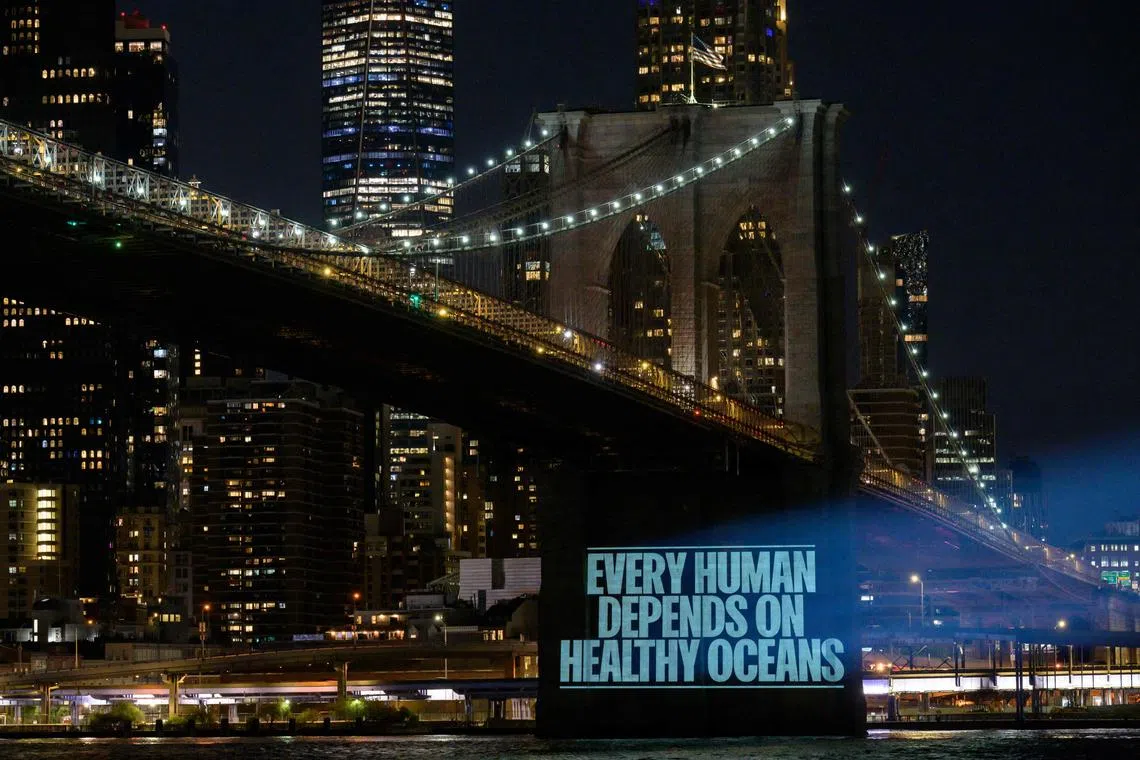All hands on deck as UN meets to protect high seas
Sign up now: Get ST's newsletters delivered to your inbox

After more than 15 years of informal and formal talks, the meeting is the third time in less than a year that negotiators are gathering.
PHOTO: AFP
Follow topic:
NEW YORK – United Nations member states are meeting in New York from Monday with the aim of launching a long-berthed high-seas treaty, a crucial step towards the goal of protecting 30 per cent of the planet by 2030.
After more than 15 years of informal and formal talks, the meeting is the third time in less than a year that negotiators are gathering for what is due to be the last round.
Two weeks of negotiations ended with no agreement in August last year,
“There are a lot of negotiations and discussions happening between delegations trying to find middle ground on some of the key sticky issues... at a level that we haven’t seen before,” said Ms Liz Karan of the non-profit Pew Charitable Trusts.
“That gives me a lot of hope that the delegations are taking this upcoming meeting to be the final final.”
This hope was bolstered in January when the United States joined the European Union (EU)-led High Ambition Coalition on Biodiversity Beyond National Jurisdiction in pushing for a quick and robust final treaty.
The 51 countries in the coalition share “the goal of urgently protecting the world’s oceans”, said EU Commissioner for Environment Virginijus Sinkevicius, noting that the new round of talks is “crucial”.
The ocean’s high seas start where nations’ exclusive economic zones end, at a maximum of 370km from the coastline, and are not under the jurisdiction of any country.
Even though these waters make up more than 60 per cent of the oceans and nearly half the planet, they have long been ignored in favour of coastal areas and certain species.
But, said Ms Nathalie Rey, campaign lead for the non-profit High Seas Alliance, there is “just one ocean and a healthy ocean means a healthy planet”.
Ocean ecosystems, threatened by pollution and overfishing, produce half the planet’s oxygen and limit global warming by absorbing a large part of the CO2 emitted by human activities.
They also absorb most of the excess heat trapped by the growing amounts of greenhouse gases in the air.
“You can’t ensure a healthy ocean if you ignore two-thirds of the ocean which make up the high seas,” Ms Rey said, adding that it would be “an absolute disaster if we ended up with nothing” from the treaty talks.
The future treaty “will be a key milestone in ensuring we achieve this 30x30 target”, she added, referencing a historic agreement in December in which every nation committed to protecting 30 per cent of all the planet’s land and ocean by 2030.
A deal at all costs?
The 30x30 goal would be almost impossible without including the high seas, of which only around 1 per cent is protected today.
One of the pillars of the future treaty on the “conservation and sustainable use of marine biodiversity in areas beyond national jurisdiction” is to allow the creation of marine protected areas in international waters.
This principle is included in the negotiating mandate voted by the UN General Assembly in 2017, but delegations are still divided on the process of creating the sanctuaries, as well as on the terms of obligations to assess the environmental impact of potential activities on the high seas.
Another contentious issue is the sharing of possible profits from use of genetic resources found in international waters, where the pharmaceutical, chemical and cosmetic industries hope to discover bankable resources.
Without the ability to carry out costly research, developing countries fear they will miss out on the potential benefits of high seas’ resources.
At the August session, observers accused rich countries, including those in the EU, of resisting to offer compromises.
With the complex and wide-ranging treaty, which will also have to contend with other organisations that have strangleholds on parts of the ocean, such as fishing and seabed mining,
“It would be better to take more time and ensure a strong agreement with political momentum, rather than hurriedly adopt a subpar agreement,” said Mr Glen Wright, senior researcher at the Institute for Sustainable Development and International Relations.
Even if, he added, another delay “would be a huge disappointment”. AFP

